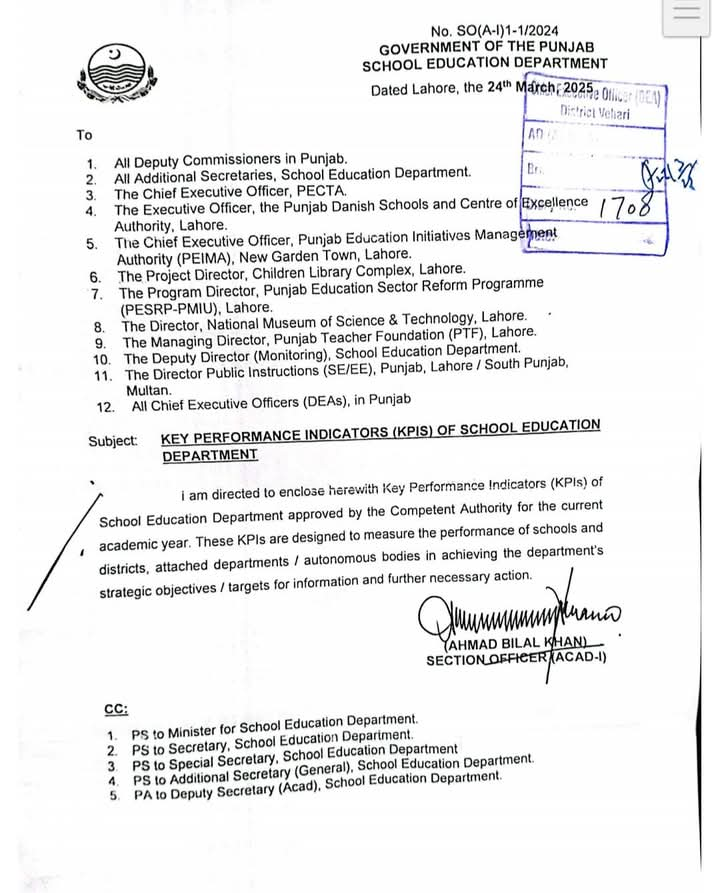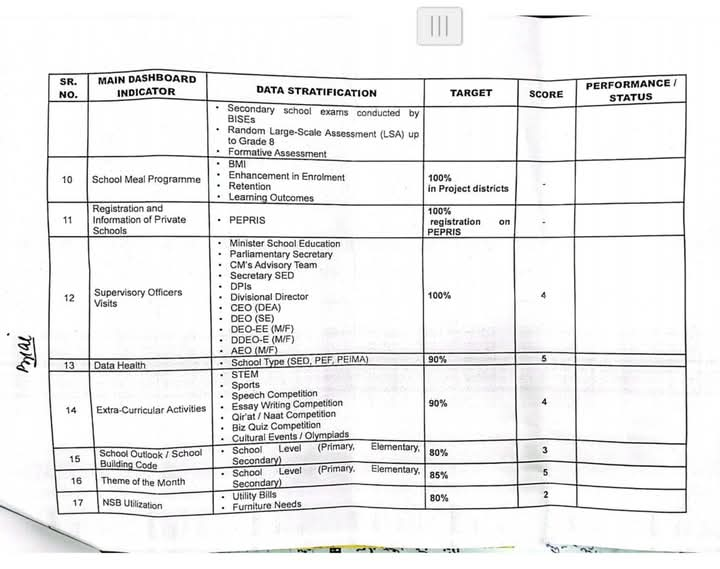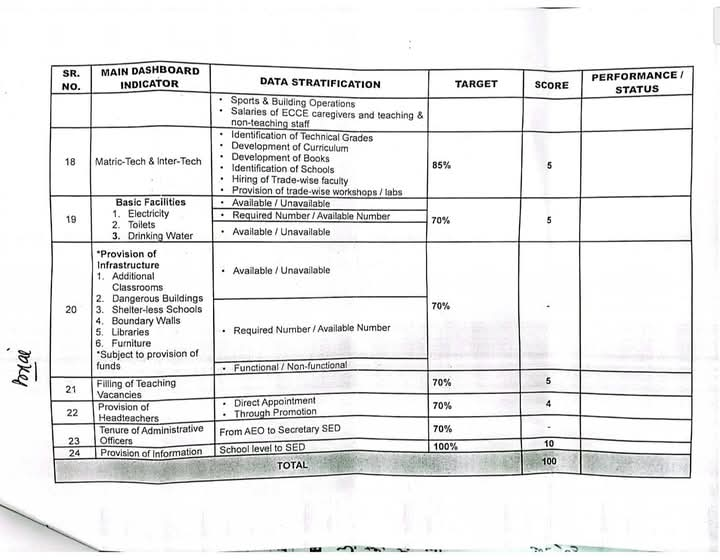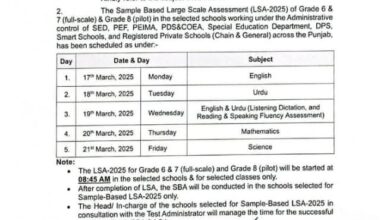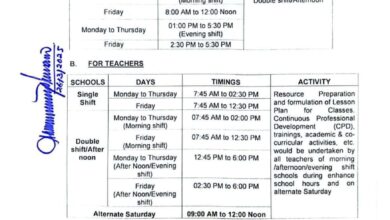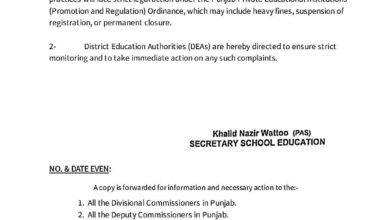Key Performance Indicators (KPIs) for School Education in Punjab
Government of Punjab School Education Department, dated March 24, 2025, outlining Key Performance Indicators (KPIs) for the School Education Department.
Key Performance Indicators (KPIs) for School Education in Punjab: A Roadmap for 2025
Contents
- 1 Key Performance Indicators (KPIs) for School Education in Punjab: A Roadmap for 2025
- 2 Overview of the KPIs Initiative
- 3 Key Areas of Focus in the KPIs
- 4 KPI Targets and Scores: A Detailed Breakdown
- 5 Impact of KPIs on Punjab’s Education System
- 6 FAQs About the KPIs for School Education in Punjab
- 6.1 1. What are the Key Performance Indicators (KPIs) for Punjab’s School Education Department?
- 6.2 2. Who is responsible for implementing these KPIs?
- 6.3 3. What happens if a school or district fails to meet the KPI targets?
- 6.4 4. How will the KPIs impact students directly?
- 6.5 5. Are private schools included in the KPIs?
- 7 Conclusion
Key Performance Indicators (KPIs) for School Education in Punjab: A Roadmap for 2025
The Punjab School Education Department has taken a significant step toward improving the quality of education by introducing a comprehensive set of Key Performance Indicators (KPIs) for the academic year 2025. Issued on March 24, 2025, by the Section Officer (ACAD-I), Ahmad Bilal Khan, this directive aims to measure the performance of schools and districts while aligning with strategic objectives. This article explores the KPIs, their targets, and their potential impact on Punjab’s education system.
Overview of the KPIs Initiative
The KPIs are designed to provide a structured framework for evaluating the performance of schools and districts under the Punjab School Education Department. The document, addressed to various stakeholders including Deputy Commissioners, Chief Executive Officers, and Program Directors, emphasizes accountability and measurable outcomes.
- Purpose: To assess the performance of schools and districts in achieving educational goals.
- Scope: Covers secondary education, infrastructure, administrative efficiency, and extracurricular activities.
- Implementation: KPIs are to be used for the current academic year, with specific targets and scoring mechanisms.
Key Areas of Focus in the KPIs
The KPIs are divided into several categories, each addressing a critical aspect of the education system. Below are the main areas of focus:
1. Secondary Education and Assessments
- Conduct Board of Intermediate and Secondary Education (BISE) exams.
- Implement Random Large-Scale Assessment (LSA) for Grade 8 students.
- Formative assessments to monitor student progress.
2. School Meal and Enrollment Programs
- Ensure 100% enhancement in enrollment in project districts.
- Focus on retention and learning outcomes.
3. Infrastructure Development
- Provide basic facilities like electricity, toilets, and drinking water (70% target).
- Address classroom availability, boundary walls, and furniture provision.
4. Administrative Efficiency
- Ensure 100% supervisory visits by officers such as the Minister, Secretary, and District Education Officers (DEOs).
- Fill teaching and headteacher vacancies (70% target).
5. Extracurricular and Cultural Activities
- Organize sports, speech, and essay writing competitions (90% target).
- Conduct cultural events and Olympiads at primary, elementary, and secondary levels (80% target).
KPI Targets and Scores: A Detailed Breakdown
The document includes a table outlining specific KPIs, their data stratification, targets, and scores. Below is a summarized version of the table:
| Sr. No. | Main Dashboard Indicator | Data Stratification | Target | Score |
|---|---|---|---|---|
| 10 | School Meal Programme | Enhancement in Enrollment, Retention, Outcomes | 100% | – |
| 11 | Registration of Private Schools | Registration on PEPRIS | 100% | – |
| 12 | Supervisory Visits | Visits by Minister, Secretary, DEOs, etc. | 100% | 4 |
| 13 | Data Health | School Type (SED, PEF, PEIMA) | 80% | 5 |
| 14 | Extracurricular Activities | Sports, Speech, Essay Writing, Cultural Events | 90% | 4 |
| 18 | Matric-Tech & Inter-Tech | Development of Curriculum, Hiring of Teachers | 85% | 5 |
| 19 | Basic Facilities (Electricity, Toilets, Water) | Available/Unavailable | 70% | 5 |
| 20 | Infrastructure (Classrooms, Buildings) | Required/Available | 70% | – |
| 21 | Filling of Teaching Vacancies | Direct Appointment | 70% | 5 |
| 23 | Tenure of Administrative Officers | From AEO to Secretary SED | 100% | 10 |
Total Score: 100
Impact of KPIs on Punjab’s Education System
The introduction of KPIs is expected to bring about several positive changes in Punjab’s education system:
- Improved Accountability: Schools and districts will be held accountable for meeting specific targets, ensuring better resource utilization.
- Enhanced Infrastructure: Focus on basic facilities and infrastructure will create a conducive learning environment.
- Holistic Development: Emphasis on extracurricular activities will promote the overall development of students.
- Data-Driven Decisions: The use of data health metrics will enable better monitoring and decision-making.
However, challenges such as resource constraints, teacher training, and regional disparities may hinder the effective implementation of these KPIs.
FAQs About the KPIs for School Education in Punjab
1. What are the Key Performance Indicators (KPIs) for Punjab’s School Education Department?
The KPIs are measurable targets set by the Punjab School Education Department to evaluate the performance of schools and districts. They cover areas like secondary education, infrastructure, administrative efficiency, and extracurricular activities.
2. Who is responsible for implementing these KPIs?
The directive is addressed to various stakeholders, including Deputy Commissioners, Chief Executive Officers, Program Directors, and District Education Officers, who are responsible for ensuring compliance.
3. What happens if a school or district fails to meet the KPI targets?
The document does not specify penalties, but the scoring system suggests that performance will be closely monitored, and underperforming entities may face increased scrutiny or corrective measures.
4. How will the KPIs impact students directly?
Students will benefit from improved infrastructure, better teaching quality, and more extracurricular opportunities, which will contribute to their academic and personal growth.
5. Are private schools included in the KPIs?
Yes, the registration of private schools on the PEPRIS system is one of the KPIs, with a target of 100%.
Conclusion
The Key Performance Indicators (KPIs) introduced by the Punjab School Education Department mark a significant step toward improving the quality of education in the region. By setting clear targets and focusing on critical areas such as infrastructure, administrative efficiency, and student development, the department aims to create a more accountable and effective education system. While challenges remain, the successful implementation of these KPIs could pave the way for a brighter future for Punjab’s students. Stakeholders at all levels must work collaboratively to achieve these targets and ensure that the education system meets the needs of the 21st century.
